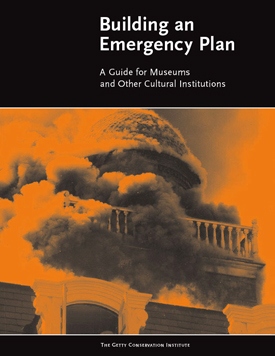
Building an Emergency Plan: A Guide for Museums and Other Cultural Institutions
Compiled by Valerie Dorge and Sharon L. Jones
1999
280 pages
PDF file size: 3.05 MB
Description
Building an Emergency Plan provides a step-by-step guide that a cultural institution can follow to develop its own emergency preparedness and response strategy. This workbook is divided into three parts that address the three groups generally responsible for developing and implementing emergency procedures—institution directors, emergency preparedness managers, and departmental team leaders—and discuss the role each should play in devising and maintaining an effective emergency plan. Several chapters detail the practical aspects of communication, training, and forming teams to handle the safety of staff and visitors, collections, buildings, and records.
Emergencies covered include natural events such as earthquakes or floods, as well as human-caused emergencies, such as fires that occur during renovation. Examples from the Barbados Museum and Historical Society, the Museo de Arte Popular Americano in Chile, the Mystic Seaport Museum in Connecticut, and the Seattle Art Museum show how cultural institutions have prepared for emergencies relevant to their sites, collections, and regions.
Table of Contents
-
Foreword
Timothy P. Whalen -
Preface
Valerie Dorge -
Introduction
- How to Use This Book
- Terms to Know
-
Part I: For the Director
-
Chapter 1: An Introduction to Emergency Preparedness and Response Planning
- Facing the Facts
- The Emergency Preparedness and Response Planning Process
- Devising the Emergency Plan
- Taking a Cue from Other Institutions
- Case 1: Barbados Museum and Historical Society
- Case 2: Museo de Arte Popular Americano
- Case 3: Mystic Seaport Museum
- Case 4: Seattle Art Museum
-
Chapter 2: The Role of the Director
- Creating an Emergency Plan
- A Team Effort
- Immediate Steps to Take
-
Chapter 1: An Introduction to Emergency Preparedness and Response Planning
-
Part II: For the Emergency Preparedness Manager
-
Chapter 3: The Role of the Emergency Preparedness Manager and the Emergency
- Preparedness Committee
- Making Emergency Preparedness Happen
- The Role of the Emergency Preparedness Manager
- The Role of the Emergency Preparedness Committee
-
Chapter 4: Communications
- Why Communication Is Important
- Developing an Effective Communications Program
-
Chapter 5: Training
- Why Training Is Important
- Who Should Be Trained?
- Where to Start?
- Emergency Preparedness and Response Training Suggestions
-
Chapter 3: The Role of the Emergency Preparedness Manager and the Emergency
-
Part III: For the Departmental Team Leaders
-
Chapter 6: The Safety and Security Team
- Your Role in the Process
- Preparing Report 1: Vulnerability and Asset Analysis
- Preparing Report 2: Outline of Response Procedures and Techniques
-
Chapter 7: The Collections Team
- Your Role in the Process
- Preparing Report 1: Vulnerability and Asset Analysis
- Preparing Report 2: Outline of Response Procedures and Techniques
-
Chapter 8: The Buildings and Maintenance Team
- Your Role in the Process
- Preparing Report 1: Vulnerability and Asset Analysis
- Preparing Report 2: Outline of Response Procedures and Techniques
-
Chapter 9: The Administration and Records Team
- Your Role in the Process
- Preparing Report 1: Vulnerability and Asset Analysis
- Preparing Report 2: Outline of Response Procedures and Techniques
-
Chapter 6: The Safety and Security Team
-
Appendixes
- A: Emergency Teams at the Barbados Museum
- B: Tables of Contents from Emergency Planning Manuals
- C: Evacuation Procedures for Staff and the Public
- D: Safety and Welfare Supervisor Job Description
- E: Emergency Response Supply Lists
- F: Collection Safety Manager Job Description
- G: Evacuation Procedures for Collections
- H: Fact Sheet List
- I: Procedures for Handling Art in an Emergency
- J: Building Systems Supervisor Job Description
- K: Human Resources Manager Job Description
- Directory of Selected Organizations
- Index
- About the Compilers
About the Authors
Valerie Dorge is a project specialist at the Getty Conservation Institute, providing
conservation, training, and project management expertise to GCI projects. As a training coordinator from 1992 to 1997, she organized a variety of courses for the institute nationally and internationally. She was an adviser for the AIC Task Force on Disaster Mitigation, Response, and Recovery, which developed a draft workshop curriculum on this topic. Previously, she was a conservator at the Canadian Conservation Institute (CCI), where her responsibilities also included participation in the institute’s emergency response team activities. Dorge is a professional associate of the American Institute for Conservation of Historic and Artistic Works (AIC), and a Fellow of the International Institute for Conservation of Historic and Artistic Works (IIC).
Sharon L. Jones is a journalist-turned-technologist with more than sixteen years’ experience in newspapers, educational products, and hypermedia publishing. She began her writing career with the Associated Press, the wire service, and spent the majority of her journalism career with the San Diego Union-Tribune. She has worked as a general assignment reporter, where she covered a variety of emergencies (bombings, earthquakes, brush fires, arson fires) and learned firsthand about the devastation they can bring. She has also worked as an education writer and has developed training materials for IBM Corporation and other companies.
Press Reviews and Awards
- “I feel stressed in having to set priorities for what should be saved in an emergency situation. My entire career is built on caring for art, and to think that I might have to leave something behind is very difficult. These are hard choices.” —Gail Joice, Seattle Art Museum
Additional Languages
- French
- Spanish